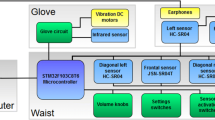Abstract
People with visual impairment have increased difficulty in performing activities of daily living, such as walking without bumping into obstacles. Many assistive technologies are used to help with ambulation as one walks forward, such as a white walking cane or a service dog. These have proven to be of tremendous help, but the cane may miss suspended objects not touching the ground, and service dogs are not available to all who need them. Further assistive technologies continue to be developed and tested. In nature, those without visual acuity tend to obtain much information from their environment through the other senses, such as hearing or tactile touch. This study is exploring the mapping of obstacle detection to tactile vibration motors on the skin. Ultrasonic sensors were used to detect obstacles in the forward direction where the user would be walking, and calculate the distance. The distance was mapped to a vibration pattern, with the pattern being more intense for closer obstacles. A prototype was developed and had several tests run. Obstacle detection and distance were useful up to 3 m. The functional field of view was 10° to 30° from centerline, but became more narrow as the distance increased and for harder to detect obstacles. The distance was mapped to 3 different vibration patterns, and human subjects were able to distinguish the patterns in a consistent manner. The prototype shows promise, but more testing and development would be required toward widespread application.
Access this chapter
Tax calculation will be finalised at checkout
Purchases are for personal use only
Similar content being viewed by others
References
Fernandes, H., Costa, P., Filipe, V., Paredes, H., Barroso, J.: A review of assistive spatial orientation and navigation technologies for the visually impaired. Univ. Access Inf. Soc. 18(1), 155–168 (2019)
Buchs, G., Simon, N., Maidenbaum, S., Amedi, A.: Waist-up protection for blind individuals using the EyeCane as a primary and secondary mobility aid. Restor. Neurol. Neurosci. 35(2), 225–235 (2017)
Froneman, T., van den Heever, D., Dellimore, K.: Development of a wearable support system to aid the visually impaired in independent mobilization and navigation. In: Presented at the 2017 39th Annual International Conference of the IEEE Engineering in Medicine and Biology Society (EMBC). IEEE, pp 783–786 (2017)
DeGuglielmo, N., Lobo, C., Moriarty, E.J., Ma, G., Dow, D.E.: Haptic vibrations for hearing impaired to experience aspects of live music. In: Nakano, T. (eds.) Bio-Inspired Information and Communications Technologies. BICT 2021. LNICST, vol. 403, pp. 71–86 . Springer, Cham (2021). https://doi.org/10.1007/978-3-030-92163-7_7
Poppinga, B., Magnusson, C., Pielot, M., Rassmus-Gröhn, K.: TouchOver map: audio-tactile exploration of interactive maps. In: Presented at the Proceedings of the 13th International Conference on Human Computer Interaction with Mobile Devices and Services, pp. 545–550 (2011)
Muender, T., Bonfert, M., Reinschluessel, A.V., Malaka, R., Döring, T.: Haptic fidelity framework: defining the factors of realistic haptic feedback for virtual reality. In: Presented at the CHI Conference on Human Factors in Computing Systems, pp. 1–17 (2022)
Tennison, J.L., Uesbeck, P.M., Giudice, N.A., Stefik, A., Smith, D.W., Gorlewicz, J.L.: Establishing vibration-based tactile line profiles for use in multimodal graphics. ACM Trans. Appl. Percept. (TAP). 17(2), 1–14 (2020)
Porquis, L.B., Finocchietti, S., Zini, G., Cappagli, G., Gori, M., Baud-Bovy, G.: ABBI: a wearable device for improving spatial cognition in visually-impaired children. In: Presented at the 2017 IEEE Biomedical Circuits and Systems Conference (BioCAS), pp 1–4. IEEE (2017)
Shiizu, Y., Hirahara, Y., Yanashima, K., Magatani, K.: The development of a white cane which navigates the visually impaired. In: Presented at the 2007 29th Annual International Conference of the IEEE Engineering in Medicine and Biology Society, pp 5005–5008. IEEE (2007)
Elmannai, W., Elleithy, K.: Sensor-based assistive devices for visually-impaired people: current status, challenges, and future directions. Sensors 17(3), 565 (2017)
Author information
Authors and Affiliations
Corresponding author
Editor information
Editors and Affiliations
Rights and permissions
Copyright information
© 2023 ICST Institute for Computer Sciences, Social Informatics and Telecommunications Engineering
About this paper
Cite this paper
Dow, D.E., Robbins, J.J., Roberts, K.C., Bannish, S.G., Cote, B.J. (2023). Wearable Vibration Device to Assist with Ambulation for the Visually Impaired. In: Chen, Y., Yao, D., Nakano, T. (eds) Bio-inspired Information and Communications Technologies. BICT 2023. Lecture Notes of the Institute for Computer Sciences, Social Informatics and Telecommunications Engineering, vol 512. Springer, Cham. https://doi.org/10.1007/978-3-031-43135-7_22
Download citation
DOI: https://doi.org/10.1007/978-3-031-43135-7_22
Published:
Publisher Name: Springer, Cham
Print ISBN: 978-3-031-43134-0
Online ISBN: 978-3-031-43135-7
eBook Packages: Computer ScienceComputer Science (R0)




